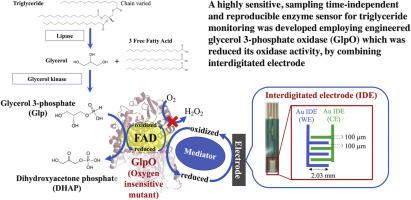Sensors and Actuators Reports Pub Date : 2023-06-01 , DOI: 10.1016/j.snr.2023.100164 Inyoung Lee , Sheng Tong , Mika Hatada , Adrianna Masterson , Kentaro Hiraka , Junko Okuda-Shimazaki , Wakako Tsugawa , Gary Hughes , Koji Sode

|
Triglycerides (TG) are an important biomarker of various diseases including hyper-lipidemia. Current emergent requirements for TG sensing include the development of electrochemical sensors for easy, cost-effective, disposable and single use triglyceride sensors. We propose a TG sensor using an engineered glycerol 3-phosphate oxidase (GlpO) and electrochemical detection. In this study, we aimed to develop an electrochemical TG sensor based on engineering the oxidative half reaction of GlpO to be oxygen insensitive, with the employment of an interdigitated electrode (IDE). To construct an oxygen insensitive mutant GlpO, we constructed a double mutant, Met104Phe/Asp169Glu, which revealed an engineered GlpO exhibiting repressed oxidase activity, while its dye-mediated dehydrogenase activity enhanced. The electrochemical enzyme sensor was constructed for the measurement of TG based on engineered GlpO using disposable screen-printed carbon electrode (SPCE) or disposable IDE using Ru complex as the electron mediator. By using the disposable IDE sensor, a highly sensitive electrochemical sensor for Glp was achieved, with the sensitivity of 0.4 µA/mM. The improved sensitivity was 2.4 times higher than that of SPCE (0.17 µA/mM), with LOD of 0.022 mM. Furthermore, the dry sensor strip, where the double mutant GlpO and Ru complex were dropcasted and dried on the IDE, was prepared and the Glp concentration was successfully measured in the delipidized serum solution. Therefore, by the employment of the established pretreatment method for TG to release Glp, a highly sensitive, accurate, easy and rapid electrochemical measurement method for TG will be developed using constructed M104F/D169E mutant GlpO with the combination of IDE.
中文翻译:

使用工程化的氧不敏感甘油 3-磷酸氧化酶开发用于甘油三酯监测的叉指电极酶传感器
甘油三酯 (TG) 是包括高脂血症在内的多种疾病的重要生物标志物。当前对 TG 传感的紧急要求包括开发电化学传感器,以实现简单、经济、一次性和一次性使用的甘油三酯传感器。我们提出了一种使用工程甘油 3-磷酸氧化酶 (GlpO) 和电化学检测的 TG 传感器。在这项研究中,我们旨在开发一种电化学 TG 传感器,该传感器基于将 GlpO 的氧化半反应设计为对氧不敏感,并使用叉指电极 (IDE)。为了构建氧不敏感突变体 GlpO,我们构建了一个双突变体 Met104Phe/Asp169Glu,它揭示了一个工程化的 GlpO 表现出抑制的氧化酶活性,而其染料介导的脱氢酶活性增强。构建电化学酶传感器用于基于工程 GlpO 使用一次性丝网印刷碳电极 (SPCE) 或使用 Ru 络合物作为电子介体的一次性 IDE 测量 TG。通过使用一次性 IDE 传感器,实现了 Glp 的高灵敏度电化学传感器,灵敏度为 0.4 µA/mM。提高的灵敏度比 SPCE (0.17 µA/mM) 高 2.4 倍,LOD 为 0.022 mM。此外,还制备了干式传感器条,其中双突变体 GlpO 和 Ru 复合物在 IDE 上滴下并干燥,并成功测量了脱脂血清溶液中的 Glp 浓度。因此,采用既定的TG预处理方法释放Glp,是一种高度灵敏、准确、



























 京公网安备 11010802027423号
京公网安备 11010802027423号